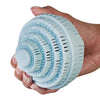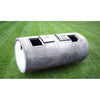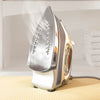Acetate Acetate is used for curtains, evening fabrics, lining materials, and as fiber fill for quilts, pillows and mattress pads. Acetate is stain, moth and mildew resistant. However, colors can fade and dyes can run. Most acetates need to be professionally cleaned, and some can be washed as delicates.
Acetic Acid Acetic acid is often used in stain removal to neutralize alkaline stains or provide a mild bleaching action. Acetic acid is available at pharmacies and photo stores in a 10 percent solution. White vinegar, a 5 percent solution of acetic acid, can also be used for spot removal. Acetic acid is especially useful because it’s safe for silk and wool, which do not tolerate alkaline spotters well. It can be used on cotton and linen if diluted with equal parts water, but test the fabric in an inconspicuous area first. It should not be used on acetate at all.
Acid If not treated promptly, alcohol can damage fabrics permanently. Immediately rinse with cold water, flushing the stained area under running water to flush out the acid. Spread the stained area over a towel or pad, and dampen with household ammonia. Repeat several times, placing a new section of the towel or pad under the stained area each time. Finally, rinse under running water. Do not use undiluted ammonia on pure wool or silk, or on blends containing either wool or silk.
Afghans Afghans can easily stretch out of shape, especially when wet, so treat them as gently as possible. A wool afghan should be washed by hand using a wool-safe detergent such as Eucalan Woolwash, in cold or lukewarm water. Avoid drying with heat. Air-dry it instead, using the air setting in your dryer. Don’t hang it to dry, or your afghan will stretch.
Afghans made of acrylic yarn are easier to care for. Using a gentle cycle, machine-wash with warm water. Machine dry on low heat. As with all handmade knits, check to see that all knots are tight before the first wash, so they won’t unravel.
Alcohol Alcohol has a multitude of uses for stain removal. It’s effective on grass stains, indelible pencil, some inks, and a number of dye stains. Pretest first, to make sure alcohol’s powerful solvent action won’t cause the fabric dye to run. Use either denatured or isopropyl alcohol for cleaning and stain removal (avoid rubbing alcohol, which may contain dyes, perfumes and excess water). Never use alcohol on wool, and always dilute 1:1 with water for use on silk or acetates.
Alpaca These yarns and fiber are obtained from the alpaca, a domesticated South American animal that looks like a llama but is a closer relative of the camel. The term alpaca is also used to refer to the fine, silky fibers obtained from llamas, and even for synthetic and synthetic/wool blends that have the luxurious feel of true alpaca. Alpaca is used primarily in tailored suits and coats and for sportswear. Classified as a woolen, it should be cared for like wool, carefully following any care label directions.
Ammonia Even a mild solution of ammonia is quite alkaline, so it works well on most acid soils and is a decent grease-cutter. For spot removal, either clear or the chemically pure 10 percent solution available at drugstores is what you want. Ammonia’s mild bleaching action makes it useful for removing a wide variety of stains. Ammonia can alter the color of some dyes, so always pretest on fabrics. If a dye change occurs, rinse with water, apply vinegar, then rinse with water again. Do be careful when using ammonia, by storing it out of reach of children, as it’s poisonous if swallowed. Don’t mix ammonia with chlorine bleach, as doing so creates toxic fumes.
Amyl Acetate Also known as banana oil, amyl acetate is a solvent that safely removes nail polish, laquer, and airplane glue from acetates and other fibers that would be damaged by acetone. You can find it at pharmacies- ask for the chemically pure kind. Amyl acetate is flammable, so keep it well away from sparks or flame.
Angora Also known as mohair, angora refers to fabrics made from the fine hair of the Angora goat. The term is also used to refer to articles made from Angora rabbit hair, although rabbit hair is not a true woolen. Angora is used alone and in blends to make fancy dress goods such as hats, suits, sweaters and mittens, and for upholstery fabrics. Care for all types of angora fabrics the same way you do for wool. (See “Wool.”)













